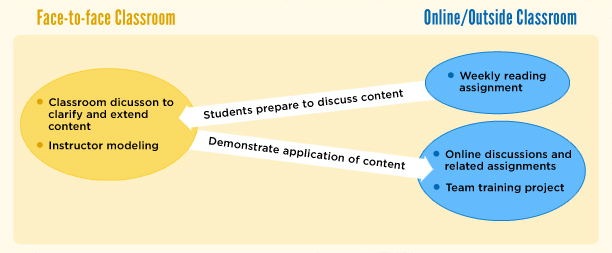Course Content
Students in blended courses frequently need help to become active learners. To nudge her students, Dr. Holland includes the following sentence in her syllabus:
You are expected to read the assigned chapters and online learning modules before coming to class in order to be prepared to participate in these and other learning activities.
For course content, her students come in prepared by reading the assigned materials. In the face-to-face classroom, Dr. Holland concentrates on extending the content through examples, case studies, and practice. Students use both reading and classroom content to complete their other assignments and demonstrate their comprehension and application and synthesis.
Here is a diagram to demonstrate the flow between online content and the face-to-face classroom.

Training Project
Students have a team based project that runs throughout the course. Each team must develop and implement a training workshop for a local organization. The process requires the teams to:
- assess learning needs
- ensure employee or volunteer readiness for training
- create a learning environment
- ensure transfer of training
- develop an evaluation plan
- select appropriate training methods for an organization
The project is completed in stages that give the teams an opportunity for feedback and modification. The components of the project are:
-
Team Memorandum
The memo identifies a team name, team members, and their top three training topic choices and why the topics were chosen. The memo is not graded but serves to get approval from the instructor.
-
Initial Instructor Manual
The initial draft of the instructor manual is graded and returned with suggestions for improvements.
-
Pilot Workshop
The pilot is not graded but serves as an opportunity to get feedback from the instructor and other students.
-
Final Instructor Manual
The team has an opportunity to review and implement suggestions and submit a final version of the instructor manual for a grade.
-
Training Workshop
The final workshop is delivered to the entire class for a grade and the
This assignment is designed to increase students’ learning by requiring the teams to utilize knowledge, comprehension, application, analysis, synthesis, and evaluation.
Now let’s take a look at the integration of the course components. In this instance, online components of the course include work with the local organization.

- The project begins with a description in the course syllabus and project documents that are contained in the course management system.
- Teams are organized in the face-to-face classroom to facilitate their socialization and speed up the development of trust.
- The course content (as discussed above) builds throughout the course and students apply it to their project.
- Students have opportunities for team meetings during the face-to-face classroom meetings that build in opportunities to ask questions and get feedback from their instructor.
- An online discussion topic is provided for each team to facilitate communication.
- The instructor manual and training workshop are largely developed outside the classroom. However, students have opportunities to get feedback and modify them in the classroom.
- In addition, they are incorporating visits to their local organization.
All these items weave back and forth between the face-to-face classroom, online content, and local organization to create a culminating project.




